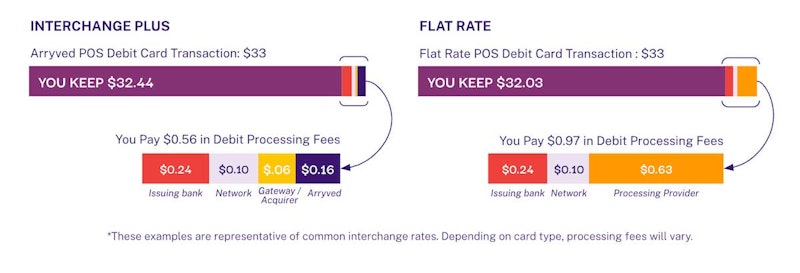SPONSORED CONTENT
Here, we’ll break down key point-of-sale (POS) fee structure terms and compare interchange Plus versus flat-rate processing.
Behold: The Processing Fee Structure Dictionary
Accessing credit card networks isn’t free, hence the reason for processing fees. There are many stakeholders that want a piece of the fees, so let’s identify our key players. (And if you find your eyes going cross while reading these definitions, don’t worry—visuals and tangible examples are coming.)
- Issuing banks: The financial institutions, such as Chase and Capital One, that issue credit and debit cards to people. Issuing banks receive the lion's share of the processing fees.
- Card networks: Organizations that set interchange rates, determine the rules, and provide the infrastructure to settle payments between banks are the card networks. These are also known as “associations” and “brands,” and familiar examples include Visa, Mastercard, and Discover.
- Interchange: The portion of the processing cost that is paid to the issuing bank, typically consisting of a percentage of the transaction amount plus a flat fee. These amounts are set by the card networks and vary by card type.
- Network fees: The portion of the processing cost that’s paid to the card network. These fees are determined by the network and include “assessments” and per-transaction fees.
- Acquiring banks: Financial institutions that process payments for merchants and settle funds to the merchant accounts. They’re also known as merchant banks.
- Credit cards: Payment cards issued to cardholders offering a line of credit that can be used to make purchases, and cardholders are then required to pay back the loan amount. Credit cards have significantly higher interchange rates than debit cards.
- Debit cards: Payment cards that deduct funds that already exist in consumer accounts. “Signature debit” cards are processed in the same manner as credit cards (no PIN required), but have much lower interchange rates than debit cards. About 45 percent of food-and-beverage industry transactions are debit!
More On Interchange
Interchange plays a large part in your brewery’s profitability, and therefore in determining the best POS processing fee structure for you.
Interchange is the pass-through cost set by card networks and issuing banks. It varies based on a guest’s card brand (Visa/Amex), type (debit/credit/rewards), and transaction type (keyed/swiped), and it’s impossible to perfectly predict ahead of time. It’s also non-negotiable, and every merchant that accepts card payments pays these fees.
This equation is how POS providers determine processing fees:
interchange plus = interchange rate + % of transaction + transaction fee
Because the interchange rate is dependent on the transaction, you should keep an eye on the last two numbers—percent of transaction and transaction fee—when comparing POS processing rates.
Compare Interchange Plus & Flat Rate Processing
Whether you make money on payment processing or not depends on two distinct factors:
- Whether you choose an interchange-plus or flat-rate fee structure
- Your business’s percentage of credit-card versus debit-card transactions (Keep in mind, 45 percent debit is standard for the food-and-beverage industry.)
Because debit cards have significantly lower interchange rates than credit cards, those transactions cost less to process. So, who saves when a debit card is swiped (or dipped or tapped)?
- The interchange-plus fee structure passes debit savings on to you.
- The flat-rate fee structure passes debit savings on to the POS provider.
This is a real example comparing two debit transactions using Arryved POS (with an interchange-plus fee structure) versus a POS provider with a flat-rate fee structure:

As you can see, Interchange Plus saves you 41 cents as compared to Flat Rate. That small change adds up over time when you consider that nearly half of your guest transactions are debit!
Because Interchange Plus charges the true pass-through cost for all card types, it means cheaper debit processing and higher growth potential for your brewery.
Continue Learning about the True Cost of Your POS System
Enlightening, eh? When all you need is more information to make critical business decisions easier, you feel inspired to gobble up all the knowledge you can.
Lucky for you, the True Cost Of Your POS System webinar will dive into all the various costs associated with your POS system. Join Mel Smith (CPA at Perkins & Co., a beverage-centric accounting firm) and Rachel Kesley (Solutions Engineer at Arryved) on March 20 at 1 p.m. MT, and you’ll leave with a better understanding of your all-in costs and see examples of where you can save.
Register for free today and you’ll receive the recording when it wraps!
SPONSORED CONTENT


